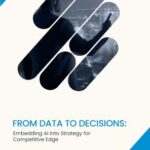or call: +1 (845) 347-8894

or call: +1 (845) 347-8894

In an era where attention is currency and trust drives conversion, tech marketers face a difficult truth: content overload has eroded traditional demand generation methods. White documents go unread. Cold emails are erased. But webinars? They create a two-way stage.
B2B buyers want personalized, intelligent experiences. Webinars deliver exactly like that, live, intent-rich environments where tech companies can educate, listen, and build relationships at scale. But webinars are no longer just events; they are data-driven demand gen engines. When positioned strategically, webinars help uncover buying signals, nurture complex accounts, and drive measurable value in the pipeline.
For modern tech firms dealing with extended sales cycles, complex products, and highly segmented audiences, webinars provide more than just engagement; they offer leverage.
Most B2B IT buyers do not convert after a single interaction. They conduct independent research, communicate with teams, and seek reliable information that addresses their individual trouble spots. Webinars bridge the gap between marketing and real contact.
Consider this: a tech business holding a live webinar on “Securing GenAI Workflows” not only demonstrates product capabilities but also educates, addresses real-time concerns, and promotes itself as a thought leader in a quickly growing sector.
Webinars let companies:
This level of involvement converts passive prospects into knowledgeable leads. Furthermore, the act of joining up communicates intent, resulting in a self-selected pool of qualified contacts that content marketing alone frequently fails to reach.
Unlike passive content like blogs or whitepapers, webinars necessitate active participation and dedication. This registration process excludes casual browsers while attracting folks who are very interested in the topic or product.
Engagement throughout the webinar creates depth to lead qualification. For instance, a participant responding to polls or hanging around till the very end indicates high interest. If your marketing automation platform is integrated with the webinar, these behavioral indicators can initiate customized nurture workflows that specifically respond to the prospect’s need or objection.
The webinar is not over when the live event finishes. Repurposing the recorded content into bite-sized videos, blog posts, or email series keeps it alive and alive much longer. These assets fuel leads through further funnel stages, reinforcing your value proposition and keeping your brand at the top of mind.
Webinars are a great tool for tailored outreach in ABM initiatives. Instead of wide, generic webinars, businesses can hold exclusive sessions for certain accounts or verticals. This concentrated strategy strengthens relationships and improves the chances of converting strategic prospects.
The most suitable webinar format is determined by your objectives and target audience. Here are four effective types:
These are required when your solution has a sophisticated user interface or several functionalities that must be shown in use. A SaaS provider, for example, may live-demonstrate new AI-powered analytics dashboards that highlight specific operations.
Bringing together subject matter experts, including analysts or product engineers, focuses on problem-solving, rather than selling. These conversations create credibility and lead attendees to see your firm as a trusted guide.
Hearing firsthand how existing customers have solved challenges using your product offers strong social proof. This approach reduces buyer hesitation and answers practical questions from a user’s perspective.
These more interactive, less scripted webinars enable prospects to interact with your product or leadership team in real time. This openness fosters trust and humanizes your brand.
Hybrid models, combining live and on-demand engagement, are increasing in popularity due to their ability to leverage the broadest reach with the most interactivity.
Webinars are most effective when linked with each stage of the buyer’s journey.
Top of the Funnel: Use wide, instructional topics to attract new audiences and increase awareness. For example, a webinar on the “Future of Edge Computing” can attract a large tech audience.
Mid-Funnel: Provide solution-focused sessions to address specific problem spots. Demos, case studies, and technical deep dives belong here.
Bottom of the funnel: Conduct client success stories and implementation workshops to assist in closing deals by resolving remaining objections and demonstrating ROI.
Integration with CRM and marketing automation solutions guarantees that leads are scored, classified, and routed efficiently. Automated nurturing routines can remind registrants to attend, contact participants afterward, and notify sales teams when leads demonstrate purchasing behavior.
Tracking webinar success takes more than simply counting registrations. Here are the main metrics:
Sales teamwork plays an important role in gaining pipeline and revenue influence. Multi-touch tracking requires attribution models to include webinar touchpoints.
Avoid these common errors to maximize webinar impact:
Webinars are evolving with new technologies that boost engagement and efficiency:
Adopting these trends early will help tech marketers stay ahead of competitors and deliver richer buyer experiences.
Webinar marketing is no longer optional. It is a strategic requirement for technology firms that want to create quality leads, educate buyers, and expedite sales. Webinars offer a unique combination of scale, interactivity, and complexity, making them suitable for sophisticated technical solutions.
Companies can achieve ongoing demand generation and stronger customer connections by investing in strategic webinar programs that are funnel-aligned, data-driven, and augmented with emerging technology.
If webinars aren’t already part of your demand generation strategy, now is the time to start. Your competitors are already doing this.
Webinar marketing in B2B technology entails hosting live or on-demand webinars to engage potential buyers, highlight expertise, demonstrate solutions, and generate leads. Unlike static material, webinars enable real-time engagement, allowing tech brands to connect with prospects and shorten the buyer process.
Webinars are extremely effective because they draw engaged and intent-rich audiences. Registrants self-select based on their interests, and real-time participation enables marketers to collect behavioral indications, address objections, and move leads down the funnel more quickly than traditional techniques.
Webinars enable customized interactions based on industry, company size, or customer profile. Hosting account-specific or industry-focused workshops improves relevance and assists sales teams in developing relationships with target accounts, making ABM outreach more personalized and effective.
A single webinar can produce weeks of content. Marketers may convert recordings into on-demand assets, repurpose Q&A into blog posts, and cut video segments for social media or email marketing. By incorporating webinars into a larger content and sales plan, technology companies may maximize ROI and keep leads engaged long after the conference has ended.
The mistakes that happen most often are overloading slides with technical jargon, failing to communicate with the audience, and failing to follow up. Webinars should feel like discussions, not speeches. Furthermore, many firms overlook the fact that the true value comes after the webinar, when they evaluate engagement data, segment follow-ups, and continue the conversation with registrants depending on their behavior and interests.
To participate in our interviews, please write to our IntentTech Media Room at sudipto@intentamplify.com




